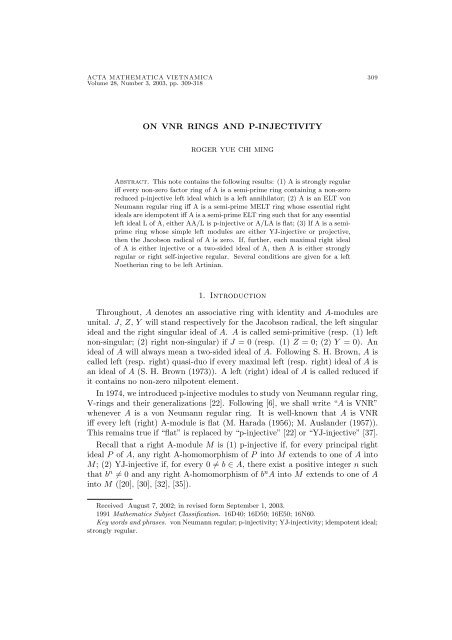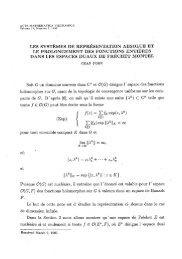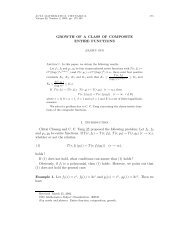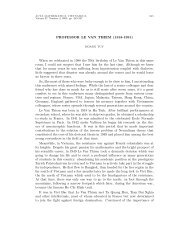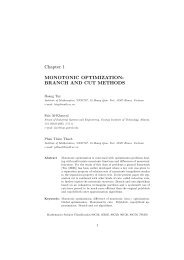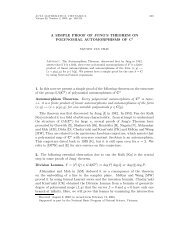ON VNR RINGS AND P-INJECTIVITY 1. Introduction Throughout, A ...
ON VNR RINGS AND P-INJECTIVITY 1. Introduction Throughout, A ...
ON VNR RINGS AND P-INJECTIVITY 1. Introduction Throughout, A ...
Create successful ePaper yourself
Turn your PDF publications into a flip-book with our unique Google optimized e-Paper software.
ACTA MATHEMATICA VIETNAMICA 309<br />
Volume 28, Number 3, 2003, pp. 309-318<br />
<strong>ON</strong> <strong>VNR</strong> <strong>RINGS</strong> <strong>AND</strong> P-<strong>INJECTIVITY</strong><br />
ROGER YUE CHI MING<br />
Abstract. This note contains the following results: (1) A is strongly regular<br />
iff every non-zero factor ring of A is a semi-prime ring containing a non-zero<br />
reduced p-injective left ideal which is a left annihilator; (2) A is an ELT von<br />
Neumann regular ring iff A is a semi-prime MELT ring whose essential right<br />
ideals are idempotent iff A is a semi-prime ELT ring such that for any essential<br />
left ideal L of A, either AA/L is p-injective or A/LA is flat; (3) If A is a semiprime<br />
ring whose simple left modules are either YJ-injective or projective,<br />
then the Jacobson radical of A is zero. If, further, each maximal right ideal<br />
of A is either injective or a two-sided ideal of A, then A is either strongly<br />
regular or right self-injective regular. Several conditions are given for a left<br />
Noetherian ring to be left Artinian.<br />
<strong>1.</strong> <strong>Introduction</strong><br />
<strong>Throughout</strong>, A denotes an associative ring with identity and A-modules are<br />
unital. J, Z, Y will stand respectively for the Jacobson radical, the left singular<br />
ideal and the right singular ideal of A. A is called semi-primitive (resp. (1) left<br />
non-singular; (2) right non-singular) if J = 0 (resp. (1) Z = 0; (2) Y = 0). An<br />
ideal of A will always mean a two-sided ideal of A. Following S. H. Brown, A is<br />
called left (resp. right) quasi-duo if every maximal left (resp. right) ideal of A is<br />
an ideal of A (S. H. Brown (1973)). A left (right) ideal of A is called reduced if<br />
it contains no non-zero nilpotent element.<br />
In 1974, we introduced p-injective modules to study von Neumann regular ring,<br />
V-rings and their generalizations [22]. Following [6], we shall write “A is <strong>VNR</strong>”<br />
whenever A is a von Neumann regular ring. It is well-known that A is <strong>VNR</strong><br />
iff every left (right) A-module is flat (M. Harada (1956); M. Auslander (1957)).<br />
This remains true if “flat” is replaced by “p-injective” [22] or “YJ-injective” [37].<br />
Recall that a right A-module M is (1) p-injective if, for every principal right<br />
ideal P of A, any right A-homomorphism of P into M extends to one of A into<br />
M; (2) YJ-injective if, for every 0 = b ∈ A, there exist a positive integer n such<br />
that b n = 0 and any right A-homomorphism of b n A into M extends to one of A<br />
into M ([20], [30], [32], [35]).<br />
Received August 7, 2002; in revised form September 1, 2003.<br />
1991 Mathematics Subject Classification. 16D40; 16D50; 16E50; 16N60.<br />
Key words and phrases. von Neumann regular; p-injectivity; YJ-injectivity; idempotent ideal;<br />
strongly regular.
310 ROGER YUE CHI MING<br />
A is called right p-injective (resp. right YJ-injective) if AA is p-injective (resp.<br />
YJ-injective). Similarly, p-injectivity or YJ-injectivity is defined on the left side.<br />
If A is right YJ-injective, then the Jacobson radical J of A coincides with the<br />
right singular ideal Y of A [30, Proposition 1] (this extends the well-known result<br />
for right self-injective rings). Also, A is right YJ-injective iff for any 0 = b ∈ A,<br />
there exist a positive integer n such that Ab n is a non-zero left annihilator [32,<br />
Lemma 3]. YJ-injectivity is also called GP-injectivity in the literature ([11], [13]).<br />
K. R. Goodearl’s textbook [8] has motivated a large number of papers on <strong>VNR</strong><br />
rings during the last twenty years. Following the study of flat modules over non-<br />
<strong>VNR</strong> rings, various authors have considered p-injective and YJ-injective modules<br />
over rings which are not necessarily <strong>VNR</strong> (cf. for example, [2], [3], [11], [13], [20],<br />
[36], [37]). As usual, A is called fully idempotent (resp. (a) fully left idempotent;<br />
(b) fully right idempotent) if every ideal (resp. (a) left ideal; (b) right ideal) of<br />
A is idempotent.<br />
The study of strongly regular rings was initiated by R. F. Arens - I. Kaplansky<br />
(1948).<br />
We start with a new characterization of strongly regular rings.<br />
Theorem <strong>1.</strong> The following conditions are equivalent:<br />
(1) A is strongly regular;<br />
(2) Every non-zero factor ring of A is a semi-prime ring containing a non-zero<br />
reduced p-injective left ideal which is a left annihilator;<br />
(3) Every non-zero factor ring of A is a semi-prime ring containing a non-zero<br />
reduced YJ-injective left ideal which is a left annihilator.<br />
Proof. Since every factor ring of a strongly regular ring is strongly regular, then<br />
(1) implies (2).<br />
(2) implies (3) evidently.<br />
Assume (3). Let B be a non-zero prime factor ring of A. Then B contains<br />
a non-zero reduced YJ-injective left ideal K which is a left annihilator. By [26,<br />
Proposition 6], B is an integral domain. Let 0 = k ∈ K. There exist a positive<br />
integer n such that any left B-homomorphism of Bk n into K extends to one of<br />
B into K. If i : Bk n → K is the natural inclusion, there exist s ∈ K such<br />
that k n = i(k n ) = k n s which implies s = 1 ∈ K, whence K = B. Since BB<br />
is YJ-injective, for any 0 = c ∈ B, there exist a positive integer m such that if<br />
g : Bc m → B is the left B-homomorphism defined by g(bc m ) = b for all b ∈ B,<br />
there exist d ∈ B such that 1 = g(c m ) = c m d which proves that B is a division<br />
ring. Since A is a fully idempotent ring, then A is <strong>VNR</strong> by [8, Corollary <strong>1.</strong>18].<br />
Therefore (3) implies (1) by [8, Theorem 3.2].<br />
A special case of left bounded rings [5, p.49] is the class of ELT rings. Recall<br />
that A is ELT if every essential left ideal of A is an ideal of A. We also say that<br />
A is MELT if any maximal essential left ideal (if it exists) is an ideal of A. ERT<br />
and MERT rings are similarly defined on the right side.
<strong>ON</strong> <strong>VNR</strong> <strong>RINGS</strong> <strong>AND</strong> P-<strong>INJECTIVITY</strong> 311<br />
Remark <strong>1.</strong> If A is <strong>VNR</strong>, then the above four terms are equivalent properties<br />
for the ring A (cf. [33, p.56]).<br />
In [28, Question 2], it is asked whether a prime MELT left or right self-injective<br />
ring A is Artinian? We know that the answer is “yes” if A has non-zero socle.<br />
Consequently, this question may be reformulated as follows:<br />
Question <strong>1.</strong> Does there exist a prime left or right self-injective ring which is left<br />
quasi-duo but not a division ring ?<br />
J. S. Alin-E. P. Armendariz [1] initiated the study of rings whose simple modules<br />
are either injective or projective (later called generalized V-rings by V. S.<br />
Ramamurthy-K. M. Rangaswamy [16]) (cf. also [2]). We consider rings whose<br />
simple right modules are either YJ-injective or projective. Note that in a semiprime<br />
ring A, if L is an essential left ideal which is an ideal of A, then L is an<br />
essential right ideal of A.<br />
The next proposition improves [25, Proposition 9(4)] and [29, Proposition 2(2)].<br />
Proposition <strong>1.</strong> The following conditions are equivalent:<br />
(1) A is an ELT <strong>VNR</strong> ring;<br />
(2) A is a semi-prime MELT ring whose simple right modules are either injective<br />
or projective;<br />
(3) A is a semi-prime MELT ring whose simple right modules are either pinjective<br />
or projective;<br />
(4) A is a semi-prime MELT ring whose essential right ideals are idempotent;<br />
(5) A is is a semi-prime ELT ring such that, for any essential left ideal L of<br />
A, either AA/L is p-injective or A/LA is flat.<br />
Proof. Assume (1). Then A is a semi-prime MELT ring which is also ERT [33,<br />
p.56]. For any maximal right ideal R of A, if A/RA is not projective, then R is<br />
an essential right ideal which is therefore an ideal of A. Since AA/R is flat, then<br />
by [29, Lemma 1], A/RA is injective. Thus (1) implies (2).<br />
(2) implies (3) evidently.<br />
(3) implies (4) by [24, Proposition 6].<br />
Assume (4). Since A is MELT and every essential right ideal of A is idempotent,<br />
then any factor ring of A has the same two properties. Let B be a prime factor<br />
ring of A. Then B is MELT and every essential right ideal of B is idempotent.<br />
For any 0 = t ∈ B, T = BtB is a non-zero ideal of B which is therefore an<br />
essential right ideal of B. There exist a complement right subideal K of T such<br />
that R = tB ⊕ K is an essential right subideal of T . Therefore R is an essential<br />
right ideal of B, which is then idempotent. Now t ∈ R 2 = R implies that<br />
where bi, ci ∈ B and ki, si ∈ K, whence<br />
t = (tbi + ki)(tci + si),<br />
t − tbi(tci + si) = ki(tci + si) ∈ B ∩ K = 0.
312 ROGER YUE CHI MING<br />
Since T is an ideal of B, then<br />
t = tbi(tci + si) ∈ tT = (tB) 2 ,<br />
which proves that tB = (tB) 2 . We have just proved that B is a fully right<br />
idempotent ring. Since B is MELT, by [34, Proposition 9], B is <strong>VNR</strong>. For any<br />
ideal I of A, let C be a complement right ideal of A such that E = I ⊕ C is an<br />
essential right ideal of A. Then E = E 2 . We now have I ⊆ I(I ⊕ C). Since<br />
(IC) 2 = I(CI)C = 0, then IC = 0 (in as much as A is semi-prime). This yields<br />
I ⊆ I 2 , whence I = I 2 . A is therefore fully idempotent and (4) implies (1) by [8,<br />
Corollary <strong>1.</strong>18].<br />
It is clear that (1) implies (5).<br />
Assume (5). For any b ∈ A, if I = AbA + l(b), K a complement left ideal<br />
of A such that L = I ⊕ K is an essential left ideal of A, since A is semi-prime,<br />
l(AbA) = r(AbA) and therefore<br />
which implies that<br />
AbAK ⊆ AbA ∩ K ⊆ I ∩ K = 0<br />
K ⊆ r(AbA) = l(AbA) ⊆ l(b),<br />
whence K ⊆ I ∩ K = 0. This proves that I = L is an essential left ideal of A.<br />
Therefore I is an ideal of A. First suppose that AA/I is p-injective. Define a left<br />
A-homomorphism<br />
f : Ab → A/I by f(ab) = a + I for all a ∈ A.<br />
There exist y ∈ A such that 1 + I = f(b) = by + I, which yields 1 − by = c + u,<br />
c ∈ AbA, u ∈ l(b). Now<br />
b = byb + cb + ub = byb + cb(Ab) 2<br />
which proves that Ab = (Ab) 2 . Next suppose that A/IA is flat. Since b ∈ I, we<br />
have b ∈ Ib [4, p.458]. If b = wb, w ∈ I, let w = s + t, where s ∈ AbA, t ∈ l(b).<br />
Then b = sb + tb = sb ∈ (Ab) 2 again and we have Ab = (Ab) 2 . We have proved<br />
that in any case A is a fully left idempotent ring. By [2, Theorem 3.1], A is <strong>VNR</strong><br />
and hence (5) implies (1).<br />
If every singular right A-module is injective, then A is a right hereditary ring<br />
(K. R. Goodearl, Singular torsion and the splitting properties, Amer. Math. Soc.<br />
Memoirs, Vol.124 (1972)). Such rings are noted right SI-rings. (Goodearl’s result<br />
remains valid if “singular right A-module” is replaced by “divisible singular right<br />
A-module” [27, p.192]).<br />
In connection with this type of result, [21, Theorem 4] asserts that if A is<br />
right non-singular, then the singular submodule of any injective right A-module<br />
is injective (cf. Abraham ZAK’s remark in Math. Reviews 40 (1970)#5664 and<br />
also [5, p.88]).<br />
We recall the following theorem of K. Goodearl in the above memoir (cf. [2,<br />
Theorem 2.7]).
<strong>ON</strong> <strong>VNR</strong> <strong>RINGS</strong> <strong>AND</strong> P-<strong>INJECTIVITY</strong> 313<br />
Theorem 2. (K. Goodearl) A is a right SI-ring if, and only if, A decomposes<br />
as:<br />
A = S × A1 × . . . · · · × An,<br />
where Soc.Ss is essential in Ss and each Ai is a simple right SI-ring which is<br />
Morita equivalent to a domain.<br />
Remark 2. Proposition 1 and Goodearl’s theorem imply that if A is a semiprime<br />
MELT right SI-ring, then A = S × A1 × dots · · · × An, where S is an<br />
ERT <strong>VNR</strong> right hereditary ring with essential right socle and each Ai is a simple<br />
Artinian ring.<br />
We know that A is <strong>VNR</strong> if every singular right A-module is flat [25, Theorem<br />
5]. As usual, A is called a right IF-ring if every injective right A-module is flat.<br />
Remark 3. If A is a right IF-ring whose singular right modules are injective,<br />
then A = S × A1 × . . . · · · × An, where S is a <strong>VNR</strong> right hereditary ring with<br />
essential right socle and each Ai is a simple <strong>VNR</strong> right hereditary ring.<br />
In Remark 2, the term “semi-prime” cannot be omitted. Indeed, ELT rings<br />
whose singular right modules are injective need not be <strong>VNR</strong>, as shown by the<br />
following example.<br />
Example. Let K be a field and<br />
A =<br />
<br />
K K<br />
.<br />
0 k<br />
A has only one proper essential left ideal<br />
<br />
K K<br />
L =<br />
0 0<br />
and L is an ideal of A. Therefore A is ELT. All singular right (and left) Amodules<br />
are injective. Although A is left and right hereditary, Artinian, A is not<br />
<strong>VNR</strong>. But A is left and right quasi-duo.<br />
The Jacobson radical J, the right and left singular ideals Y , Z of A respectively<br />
are fundamental concepts in ring theory (cf. [5], [6], [7], [8], [19]).<br />
Proposition 2. Suppose that every simple right A-module is either YJ-injective<br />
or projective. Then Y ∩ J = 0.<br />
Proof. Suppose that Y ∩ J is a non-zero reduced ideal of A. If 0 = w ∈ Y ∩ J,<br />
r(w) is an essential right ideal of A and wA ∩ r(w) = 0. Let b ∈ A such that<br />
0 = wb ∈ r(w). Since Y ∩ J is reduced, wb ∈ Y ∩ J, wbw ∈ Y ∩ J, then<br />
implies that wbw = 0 and then<br />
(wbw) 2 = wb(w 2 b)w = 0<br />
(wb) 2 = (wbw)b = 0<br />
implies that wb = 0, a contradiction ! This proves that if Y ∩ J = 0, then Y ∩ J<br />
contains a non-zero nilpotent element. There exist 0 = z ∈ Y ∩ J such that
314 ROGER YUE CHI MING<br />
z 2 = 0. Now L = AzA + r(z) is an essential right ideal of A. If we suppose that<br />
L = A, let M be a maximal right ideal of A containing L. Then A/MA is simple<br />
non-projective (because MA is essential in AA) which implies that A/MA is YJinjective.<br />
Since z = 0, z 2 = 0, define a right A-homomorphism g : zA → A/M<br />
by g(za) = a + M for all a ∈ A. Then there exist d ∈ A such that g(z) = dz + M<br />
which yields 1 − dz ∈ M. Since dz ∈ L ⊆ M, then 1 ∈ M which contradicts<br />
M = A. This proves that L = A. Now 1 = c + u, c ∈ AzA, u ∈ r(z), and<br />
z = zc + zu = zc. Since c ∈ AzA ⊆ J, 1 − c is right invertible in A which implies<br />
that z = 0, a contradiction ! We finally have Y ∩ J = 0.<br />
The next corollary follows from a well-known result of Y. Utumi [18, Lemma<br />
4.1].<br />
Corollary <strong>1.</strong> If A is a right continuous ring whose simple right modules are<br />
either YJ-injective or projective, then A is <strong>VNR</strong>.<br />
[16, Theorem 3.3] toghether with Proposition 2 yield the following characterization<br />
of generalized V-rings.<br />
Corollary 2. The following conditions are equivalent:<br />
(1) Every simple right A-module is either injective or projective;<br />
(2) Every simple right A-module is either YJ-injective or projective and every<br />
proper essential right ideal of A is the intersection of maximal right ideals of A.<br />
If A is left non-singular, it is well-known that the injective hull of AA is a<br />
left self-injective regular ring. For an arbitrary ring A, the injective hull needs<br />
not be a ring and it is not always possible to embed A in a self-injective ring [6,<br />
p.309]. However, P. Menal-P. Vamos [12] showed that any ring may be embedded<br />
in FP-injective ring. Consequently, any ring may be embedded in a p-injective<br />
ring. This enhances the attention paid to p-injective rings (cf. for example, [6,<br />
Theorem 6.4], [9], [14], [15]). Some authors prefer the expression “principally<br />
injective” in full (cf. for example T. Y. Lam: Lectures on modules and rings,<br />
Graduate texts in Math. Springer (1998)). However, the term “p-injective” is<br />
used by Wisbauer [19] and Faith [6].<br />
Remark 4. If A is a left p-injective ring, then any finitely generated projective<br />
left a-module is p-injective.<br />
Note that in a semi-prime ring A, the sum of all reduced ideals of A is the<br />
unique maximal reduced ideal of A [31, Lemma <strong>1.</strong>].<br />
Proposition 3. Let A be a left p-injective ring such that A = B ⊕ C, where B,<br />
C are ideals of A. Then B and C are left p-injective rings.<br />
In general, a semi-prime left p-injective ring A needs not be regular (even if A<br />
is a P.I. ring) (cf. [3,p.853]).<br />
Corollary 3. Let A be a semi-prime left p-injective ring such that A = B ⊕ C,<br />
where B, C are ideals of A, B being the sum of all reduced ideals of A, C being
<strong>ON</strong> <strong>VNR</strong> <strong>RINGS</strong> <strong>AND</strong> P-<strong>INJECTIVITY</strong> 315<br />
a left p.p. ring. Then A is the direct sum of a <strong>VNR</strong> ring and a strongly regular<br />
ring.<br />
Proof. B is a reduced left p-injective ring and therefore strongly regular by [23,<br />
Theorem 1]. C is a left p-injective left p. p. ring and therefore <strong>VNR</strong>.<br />
We propose a nice result which is quite general.<br />
Proposition 4. Let A be a semi-prime ring whose simple left modules are either<br />
YJ-injective or projective. Then A is semi-primitive.<br />
Proof. We first prove that J is reduced. Suppose the contrary: Let 0 = c ∈ J<br />
such that c 2 = 0. If Ac = (Ac) 2 , we deduce a contradiction. The set of left<br />
ideals I of A such that (Ac) 2 ⊆ I ⊂ Ac has, by Zorn’s Lemma, a maximal<br />
member M. Then AAc/M is simple. Now, for any left subideal K of Ac such<br />
that K ∩ (Ac) 2 = 0, we have K 2 ⊆ K ∩ (Ac) 2 = 0 which implies K = 0 (because<br />
A is semi-prime). Therefore A(Ac) 2 is essential in AAc which implies that AM<br />
is essential in AAc. By hypothesis, AAc/M is YJ-injective. Define a left Ahomomorpjism<br />
g : Ac → Ac/M by g(ac) = ac + M for all a ∈ A. There exist<br />
d ∈ A such that<br />
c + M = g(c) = cdc + M.<br />
Then c − cdc ∈ M which yields c ∈ M (since cdc ∈ (Ac) 2 ⊆ M), whence<br />
M = Ac, a contradiction ! Therefore Ac = (Ac) 2 which implies that c = uc,<br />
where u ∈ AcA ⊆ J. Since 1 − u is left invertible in A, c = 0 which contradicts<br />
our original assumption. This proves that J is reduced.<br />
We now prove that J = 0. If not, let 0 = v ∈ J. Let K be a complement left<br />
ideal of A such that L = (AvA + l(v)) ⊕ K is an essential left ideal of A. Then<br />
vK ⊆ AvA ∩ K = 0 which implies that (Kv) 2 = 0, whence Kv = 0. Therefore<br />
K ⊆ l(v) which yields K = K ∩ l(v) = 0, showing that L = AvA + l(v) is an<br />
essential left ideal. If L = A, let N be a maximal left ideal of A such taht L ⊂ N.<br />
Then AA/N is simple, YJ-injective. There exist a positive integer m such that<br />
any left A-homomorphism of Av m into A/N extends to A. Since A is reduced,<br />
we may define a left A-homomorphism h : Av m → A/N by h(av m ) = a + N for<br />
all a ∈ A. There exist w ∈ A such that h(v m ) = v m w + N. Now 1 + N = h(v m )<br />
implies that 1 − v m w ∈ N, whence 1 ∈ N, contradicting N = A. This proves<br />
that L = A. If 1 = s + t, s ∈ AvA, t ∈ l(v), then v = sv + tv = sv and since<br />
s ∈ AvA ⊆ J, 1 − s is left invertible in A which yields v = 0, a contradiction. We<br />
have proved that J = 0.<br />
Corollary 4. Let A be a semi-prime ring whose simple left modules are either<br />
YJ-injective or projective. If each maximal right ideal of A is either injective or<br />
an ideal of A, then A is either strongly regular or right self-injective regular.<br />
Proof. First suppose that each maximal right ideal of A is an ideal of A. Since<br />
A is semi-primitive by proposition 4 and right quasi-duo, then A is a reduced<br />
ring (cf. R. Yue Chi Ming, On von Neumann regular rings VI, Rend. Sem. Mat.
316 ROGER YUE CHI MING<br />
Univ. Torino 39 (1981), 75-84 (p. 82)). By [11, Proposition 18], A is strongly<br />
regular. Now suppose there exist a maximal right ideal M which is not an ideal<br />
of A. Then MA is injective and by [34, Lemma 4], A is right self-injective. Since<br />
J=0, A is <strong>VNR</strong>.<br />
In Corollary 4, the term “semi-prime” is not superfluous (cf. the example given<br />
above). Another remark on p-injective rings.<br />
Remark 5. If A is a left p-injective ring such that (a) every complement left<br />
ideal is a direct summand of AA and (b) every simple left A-module is either<br />
YJ-injective or projective, then A is <strong>VNR</strong>. (Rings satisfying condition (a) are<br />
studied in [10]).<br />
We now give various conditions for left Noetherian rings to be left Artinian.<br />
Theorem 3. The following conditions are equivalent:<br />
(1) A is left Artinian;<br />
(2) A is a left Noetherian ring such that any non-zero prime factor ring B<br />
satisfies any one of the following conditions: (a) B has non-zero socle; (b) B<br />
contains a p-injective maximal left ideal; (c) B is left YJ-injective; (d) B is right<br />
YJ-injective.<br />
Proof. (1) implies (2) evidently.<br />
Assume (2). Let B be a non-zero prime factor ring of A.<br />
(a) If B has non-zero left (and right) socle S, then BS, being essential in BB<br />
and also a direct summand of BB, implies that B = S, which shows that B is<br />
simple Artinian.<br />
(b) If B contains a p-injective maximal left ideal K, then BK is finitely generated<br />
(since B is left Noetherian) and given BK is p-injective, then B/K is a<br />
finitely related flat left B-module which implies that BB/K is projective, whence<br />
B = K ⊕ V , where V is a minimal projective left ideal of B. Since B is prime,<br />
K cannot be an ideal of B and the proof of [34, Lemma 4] shows that B is a left<br />
p-injective ring. Therefore (b) implies (c).<br />
(c) Since BB is YJ-injective, then every non-zero-divisor is invertible in B<br />
which implies that B coincides with its classical left (and right) quotient ring.<br />
By a well-known theorem of A. W. Goldie, B is simple Artinian.<br />
(d) If B is right YJ-injective, then B is Artinian as in (c).<br />
In any case, B must be Artinian. If A is prime, then A is simple Artinian as<br />
just seen. If A is not prime, since any proper prime factor ring of A is Artinian,<br />
by [5, Lemma 18.34B], A must be left Artinian. We have proved that (2) implies<br />
(1).<br />
Finally, we give a “test module” for a ring to be strongly regular with non-zero<br />
socle.<br />
Theorem 4. The following conditions are equivalent:<br />
(1) A is strongly regular with non-zero socle;
<strong>ON</strong> <strong>VNR</strong> <strong>RINGS</strong> <strong>AND</strong> P-<strong>INJECTIVITY</strong> 317<br />
(2) A contains a finitely generated reduced YJ-injective maximal left ideal.<br />
Proof. (1) implies (2) evidently.<br />
Assume (2). Since A contains a finitely generated YJ-injective maximal left<br />
ideal M which is reduced, then A is a reduced ring [33, Lemma 2]. Let 0 = b ∈ M.<br />
There exist a positive integer n such that any left A-homomorphism of Ab n into<br />
M extends to A. If j : Ab n → M is the natural inclusion, there exist y ∈ M such<br />
that b n = j(b n ) = b n y. Now 1 − y ∈ r(b n ) = r(b) (because A is reduced). Then<br />
b = by ∈ bM which proves that AA/M is flat [4, p.458]. Now AA/M is finitely<br />
related flat which is therefore projective. Let A = M ⊕ U, where U is a minimal<br />
left ideal of A. Since A is reduced, then AU must be injective. Since AM is<br />
YJ-injective, then A = M ⊕ U is left YJ-injective. Therefore A is a reduced left<br />
YJ-injective ring which is then strongly regular by [30, Proposition 1(2)]. Thus<br />
(2) implies (1).<br />
We are unable to answer the following questions.<br />
Question 2. Is a MELT fully idempotent right p-injective ring <strong>VNR</strong> ? (MELT<br />
fully idempotent rings need not be <strong>VNR</strong> [36]).<br />
Question 3. If A contains a reduced p-injective maximal left ideal, is A strongly<br />
regular ?<br />
Acknowledgement<br />
I would like to thank the referee for helpful comments and suggestions leading<br />
to this improved version of the paper.<br />
References<br />
[1] J. S. Alin and E. P. Armendariz, A class of rings having all singular simple modules injective,<br />
Math. Scand. 23 (1968), 233-240.<br />
[2] G. Bacella, Generalized V-rings and von Neumann regular rings, Rend. Sem. Mat. Univ.<br />
Padova 72 (1984), 117-133.<br />
[3] K. Beidar and R. Wisbauer, Properly semi-prime self pp-modules, Comm. Algebra 23<br />
(1995), 841-86<strong>1.</strong><br />
[4] S. U. Chase, Direct products of modules, Trans. Amer. Math. Soc. 97 (1960), 457-473.<br />
[5] C. Faith, Algebra II: Ring theory. Grundlehren 19 (1976).<br />
[6] C. Faith, Rings and things and a fine array of twentieth century associative algebra. AMS<br />
Math. Surveys and Monographs 65 (1999).<br />
[7] J. K. R. Goodearl, Ring theory : Non singular rings and modules. Marcel Dekker, New<br />
York (1976).<br />
[8] J. K. R. Goodearl, Von Neumann Regular Rings. Pitman, London (1979).<br />
[9] Y. Hirano, On non-singular p-injective rings, Publ. Math. 38 (1994).<br />
[10] D. V. Huynh, N. V. Dung, P. F. Smith and R. Wisbauer, Extending Modules, Pitman,<br />
London (1994).<br />
[11] N. K. Kim, S. B. Nam and J. Y. Kim, On simple singular GP-injective modules, Comm.<br />
Algebra 27 (1999), 2087-2096.<br />
[12] P. Menal and P. Vamos, Pure ring extensions and self-FP-injective rings, Math. Proc.<br />
Cambridge Phil. Soc. 105 (1989), 447-458.
318 ROGER YUE CHI MING<br />
[13] S. B. Nam, N. K. Kim and J. Y. Kim, On simple GP-injective modules, Comm. Algebra<br />
23 (1995), 5437-5444.<br />
[14] W. K. Nicholson and M. F. Yousif, Principally injective rings, J. Algebra 174 (1995), 77-93.<br />
[15] G. Puninski, R. Wisbauer and M. F. Yousif, On p-injective rings, Glasgow Math J. 37<br />
(1995), 373-378.<br />
[16] V. S. Ramamurthi and K. M. Rangaswamy, Generalized V-rings, Math. Scand. 31 (1972),<br />
69-77.<br />
[17] A. A. Tuganbaev, Rings whose non-zero modules have maximal submodules, J. Math. Sci.<br />
109 (2002), 1589-1640.<br />
[18] Y. Utumi, On continuous rings and self-injective rings, Trans. Amer. Math. Soc. 118 (1965),<br />
158-173.<br />
[19] R. Wisbauer, Foundations of module and ring theory. Gordon and Breach, New York (1991).<br />
[20] W. Xue, A note on YJ-injectivity, Riv. Mat. Univ. Parma (6)1 (1998), 31-37.<br />
[21] R. Yue Chi Ming, A note on singular ideals, Tôhoku Math. J. 21 (1969), 337-342.<br />
[22] R. Yue Chi Ming, On von Neumann regular rings, Proc. Edinburgh Math. Soc. 19 (1974),<br />
89-9<strong>1.</strong><br />
[23] R. Yue Chi Ming, On annihilator ideals, Math. J. Okayama Univ. 19 (1976), 51-53.<br />
[24] R. Yue Chi Ming, On von Neumann regular rings, II, Math. Scand. 39 (1976), 167-170.<br />
[25] R. Yue Chi Ming, On generalizations of V-rings and regular rings, Math. J. Okayama Univ.<br />
20 (1978), 123-129.<br />
[26] R. Yue Chi Ming, On V-rings and prime rings, J. Algebra 62 (1980), 13-20.<br />
[27] R. Yue Chi Ming, On injective and p-injective modules, Riv. Mat. Univ. Parma (4) 7 (1981),<br />
187-197.<br />
[28] R. Yue Chi Ming, On V-rings and unit-regular rings, Rend. Sem. Mat. Univ. Padova 64<br />
(1981), 127-140.<br />
[29] R. Yue Chi Ming, On regular rings and Artinian rings, Riv. Mat. Univ. Parma, (4) 8 (1982),<br />
443-452.<br />
[30] R. Yue Chi Ming, On regular rings and self-injective rings, II, Glasnik Mat. 18(38) (1983),<br />
221-229.<br />
[31] R. Yue Chi Ming, A note on semi-prime rings, Monatsheffe fr Math. 101 (1986), 173-182.<br />
[32] R. Yue Chi Ming, On regular rings and Artinian rings, II, Riv. Mat. Univ. Parma (4) 11<br />
(1985), 101-109.<br />
[33] R. Yue Chi Ming, Annihilators and strongly regular rings, Rend. Sem. Fac. Sc. Univ. Cagliari<br />
57 (1987), 51-59.<br />
[34] R. Yue Chi Ming, On self-injectivity and regularity, Rend. Sem. Fac. Sc. Univ. Cagliari 64<br />
(1994), 9-24.<br />
[35] R. Yue Chi Ming, A note on YJ-injectivity, Demonstratio Math. 30 (1997), 551-556.<br />
[36] J. Zhang, Fully idempotent rings whose every maximal left ideal is an ideal, Chinese Sc.<br />
Bull. 37 (1992), 1065-1068.<br />
[37] J. Zhang and J. Wu, Generalizations of principal injectivity, Algebra Colloquium 6 (1999),<br />
277-282.<br />
Universite Paris VII-Denis Diderot<br />
UFR Maths-Umr 9994 CNRS<br />
2, Place Jussieu, 75251 Paris Cedex 05 France


